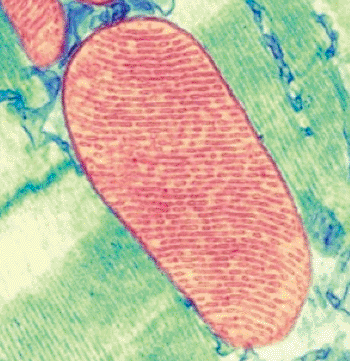Increased Mitochondrial Superoxide Levels Diminish Symptoms of Diabetic Kidney Disease
By LabMedica International staff writers
Posted on 04 Nov 2013
In vivo studies carried out with chronically diabetic mice have demonstrated a sharp reduction in the production of superoxide anion in the kidney and have shown that restoration of superoxide production reversed most diabetes symptoms.Posted on 04 Nov 2013
Models of impaired diabetic kidney function generally suggest that chronically high glucose levels stimulate mitochondria in cells to produce an overabundance of superoxide anion, a highly reactive, toxic species that ultimately leads to downstream cellular damage, organ dysfunction, and disease.

Image: Transmission electron micrograph of a cell mitochondrion (Photo courtesy of Thomas Deerinck, National Center for Microscopy and Imaging Research, University of California, San Diego).
However, a paper published in the October 25, 2013, online edition of Journal of Clinical Investigation has proposed a radically different metabolic role for superoxide anions in diabetes.
Investigators at the University of California, San Diego (USA) worked with the steptozotocin-induced mouse model of type I diabetes. They assayed superoxide production in the kidneys of these animals using an in vivo real-time transcutaneous fluorescence method combined with confocal microscopy and electron paramagnetic resonance analysis.
Results showed that superoxide production was reduced in the kidneys of these animals. Furthermore, reduction of mitochondrial biogenesis and phosphorylation of pyruvate dehydrogenase (PDH) were observed in kidneys from diabetic mice. These observations were consistent with an overall reduction of mitochondrial glucose oxidation. Activity of AMPK (5' AMP-activated protein kinase), the major energy-sensing enzyme, was reduced in kidneys from both diabetic mice and humans.
Mitochondrial biogenesis, PDH activity, and mitochondrial complex activity were restored by treatment with the AMPK activator 5-aminoimidazole-4-carboxamide-1-beta-D-ribofuranoside (AICAR). AICAR treatment induced superoxide production and was linked with glomerular matrix and albuminuria reduction in the diabetic kidney.
These results demonstrated that diabetic kidneys had reduced superoxide and mitochondrial biogenesis, and that activation of AMPK enhanced superoxide production and mitochondrial function while reducing disease activity.
“Mitochondrial superoxide does not seem to be a causative factor of diabetic kidney disease,” said senior author Dr. Kumar Sharma, professor of medicine at the University of California, San Diego. “Indeed, when mitochondrial superoxide is increased with AMPK activation, there is reduced kidney disease, suggesting that improving mitochondrial function and superoxide production is actually beneficial for diabetic complications. This idea is a sea change in the field of diabetic complications. Methods will need to be developed to monitor mitochondrial function in animal models and in clinical trials. The study of metabolites may be of great value to monitor mitochondrial noninvasively. Other methods, such as novel imaging tools like the one described in our paper, will also be important to follow mitochondrial superoxide production. It is interesting to note that recent studies by other groups have suggested that stimulating mitochondrial superoxide production may actually increase longevity and contribute to the benefits of exercise.”
Related Links:
University of California, San Diego




 assay.jpg)









